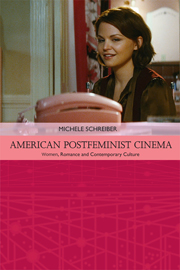Book contents
- Frontmatter
- Contents
- Acknowledgments
- List of Illustrations
- Introduction: Women, Postfeminism and Romance
- 1 ‘Both Glad and Sorry’: Romance Cycles and Women's Politics
- 2 Pragmatism vs. Sentimentality: Amelioration in the Postfeminist Cycle
- 3 Past vs. Present: Temporality in the Postfeminist Cycle
- 4 Sexy vs. Funny: Sexuality in the Postfeminist Cycle
- 5 Independence vs. Dependence: Economics in the Postfeminist Cycle
- Conclusion: Beginnings vs. Endings: the Future of the Postfeminist Cycle
- Selected Bibliography
- Index
5 - Independence vs. Dependence: Economics in the Postfeminist Cycle
Published online by Cambridge University Press: 05 September 2014
- Frontmatter
- Contents
- Acknowledgments
- List of Illustrations
- Introduction: Women, Postfeminism and Romance
- 1 ‘Both Glad and Sorry’: Romance Cycles and Women's Politics
- 2 Pragmatism vs. Sentimentality: Amelioration in the Postfeminist Cycle
- 3 Past vs. Present: Temporality in the Postfeminist Cycle
- 4 Sexy vs. Funny: Sexuality in the Postfeminist Cycle
- 5 Independence vs. Dependence: Economics in the Postfeminist Cycle
- Conclusion: Beginnings vs. Endings: the Future of the Postfeminist Cycle
- Selected Bibliography
- Index
Summary
A father-daughter shopping scene figures prominently in the 2000 Nancy Meyers film What Women Want. Nick (Mel Gibson), who has been recently endowed with a gift to hear women's thoughts, takes the teenage Alex (Ashley Johnson) to a brightly lit store filled with colorful clothes in order to embark on what is deemed the second most important shopping experience of a woman's life: finding the perfect prom dress. Shopping here is a form of bonding between the father and daughter whose relationship has been strained until Nick's ‘gift’ enables him to hear his daughter's negative opinion of him. The film suggests that their estrangement can be easily overcome through one satisfying shopping experience, and indeed this sequence consequently proves to be a turning point in their relationship.
The sequence is a montage without dialogue set to the song ‘What a Girl Wants’ by Christina Aguilera, and features Alex trying on a variety of different dresses and outfits, looking for the one that will be most likely to secure her the best, and presumably most romantic evening. Alex and Nick exchange a series of playful glances in a shot-reverse-shot structure typical of the intensified continuity system that sees him approving or disapproving each outfit choice. Nick soon becomes bored, and in response to one of the better dress choices, holds up a sign that reads, ‘How much?’ This is a humorous and playful response to his daughter's obvious indifference to the costs of her perfect prom experience. It might also be read as an unintentional Brechtian device used to call attention to the degree to which Alex and the (presumably female) viewer's pleasure is intertwined with excessive spending and consumption.
- Type
- Chapter
- Information
- American Postfeminist CinemaWomen, Romance and Contemporary Culture, pp. 140 - 169Publisher: Edinburgh University PressPrint publication year: 2014



